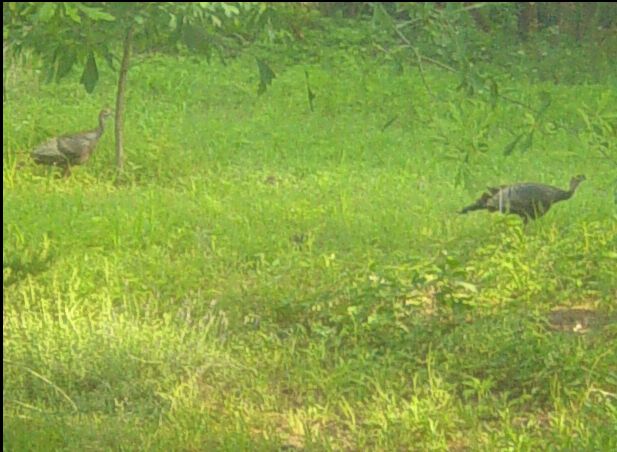MUSINGS
FROM THE MARSH
Ann
Woodlief
VI. Change
and Turkey Talk
Changes in the natural world can be very hard for us to track, especially as individuals, because they happen so slowly. After all, scientific observation is comparatively recent, and natural change and evolution can move on the scale of centuries rather than years. Often we find the causes long after a species has vanished, if we can even do that. The trustworthy data is just not there, except for changes which are happening today at a disturbing rate.
Before there were professional ecologists and botanists there were close natural observers like Henry David Thoreau and his disciple Alfred Hosmer keeping a close eye on the flora and fauna of Concord, Massachusetts. Their detailed records may not fit modern scientific standards and nomenclature in all respects, but they are proving incredible resources for understanding what we are missing today in one place. Almost one-third of the flower species can no longer be found, including 14 orchid species. 36% of the remaining species are on the edge of vanishing. Flowers are blooming up to a week earlier now. Not all change is necessarily loss, though that is what is generally emphasized.
Even up close, one can see changes on an almost annual basis. What they mean is an open question though. For example, this has been the year of the wild turkey in our corner of the Middle Peninsula. A flock of up to thirty, and that generally does not include gobblers, has taken over our yards, woods,--and hearts.

For years we occasionally saw turkey mothers and their poults parading through the yard, staying close to the marsh. In the early mornings of the spring, there was always a gobbler or two near the marsh, gobbling in hopes of luring a mate-or more likely, mates.
But then our neighbor built a house and cleared a yard close to where their usual nest. We feared that their long-term habitat had been disrupted. Evidently turkey habits are well entrenched, in spite of the clearing and the neighbor who boasted of "bagging" a big gobbler in a nearby yard.
Most mornings this spring we saw a family of six, with tiny poults, browsing in the grass along our dirt road. By August the troop had swollen. I was remiss in mowing, and the grass sprouted long seeded blades. Several times a week we found the whole group, including a male who seemed unusually attached to a single female, eating warily in the yard in the mornings and early evenings. My neighbors and I decided to retire our lawnmowers temporarily.
The turkeys would disappear, melting into the woods, if disturbed, but as long as we stayed inside, the guarding adults looked, clucked, but kept to their routine. One male--the one with a mate--came to the porch several times, looking at his threatening reflection and loudly bumping the glass.
These are low-impact animals. They have left little more than an assortment of feathers in the grass all over the neighborhood. The turkeys will eat almost anything small, but they seem to prefer grasses, insects, and acorns. Dogwoods, blueberries, and flowers are also tempting, but so far ours have been spared, aside from some beheaded chrysanthemums. In short, they have been ideal wild pets--quietly going about their own business without eating up our carefully tended plants.
Benjamin Franklin may have been right; perhaps our national bird should have been the wild turkey, "a much more respectable Bird, and withal a true original Native of America," as he wrote his daughter. He called the turkey "though a little vain & silly, a Bird of Courage," and watching them protect their young, I would agree, though I don't find them silly in spite of their little bumpy heads.
The bald eagle may be magnificent with his flashing white feathers, but he is a fierce predator. Perhaps that is more fitting for an American symbol, although the protectiveness of the turkey might be a better model. It may not soar as high, but it can fly from danger at up to 80 miles per hour, in the blink of an eye.
Many country people think of the wild turkey as game, and good to eat. In Virginia the majority of turkeys are killed around Thanksgiving with almost 5000 killed in last year's hunting seasons. One estimate projects over four million turkeys now in the US, although I don't see how one could count them.
I'm not a hunter, but to some degree I can understand the excitement of stalking a gobbler. Yet after all of these recent turkey encounters, I'm less sympathetic. My hunting neighbor has agreed that he will leave our neighborhood troop alone, at least for this year. It just would not be very sportsmanlike.
Once the weather turned cold and the grasses were stripped of their seeds, the turkeys seem to have disappeared. I know they are well hidden in the woods and bushes, somewhere, eating and waiting until the excitement of spring. We'll see their tracks in the snow soon.
This abundance doesn't mean that we haven't experienced apparent losses, even in the short time frame of several years. The tree frogs which cling to our windows, and lady bugs which once invaded our houses by the hundreds, have diminished remarkably. Those who watch birds report several song birds failing to return in the spring, although we are thrilled with the increasing numbers of egrets, hawks, and bald eagles--and even buzzards seem to be on the rise out here.
Natural change happens, and usually we humans have no more control than we do over our own aging and death. But what we can do is to foster the habitats the animals and plants need and to celebrate those that do grace us with their presence, perhaps even more because they may be transitory and not visit again.
Pleasant Living Magazine, January/February 2009